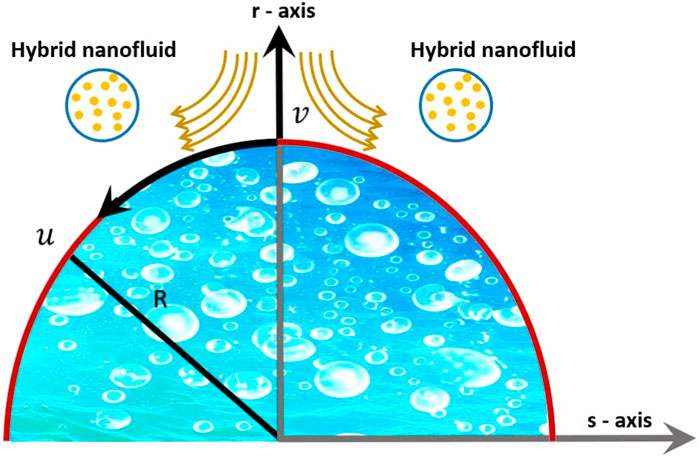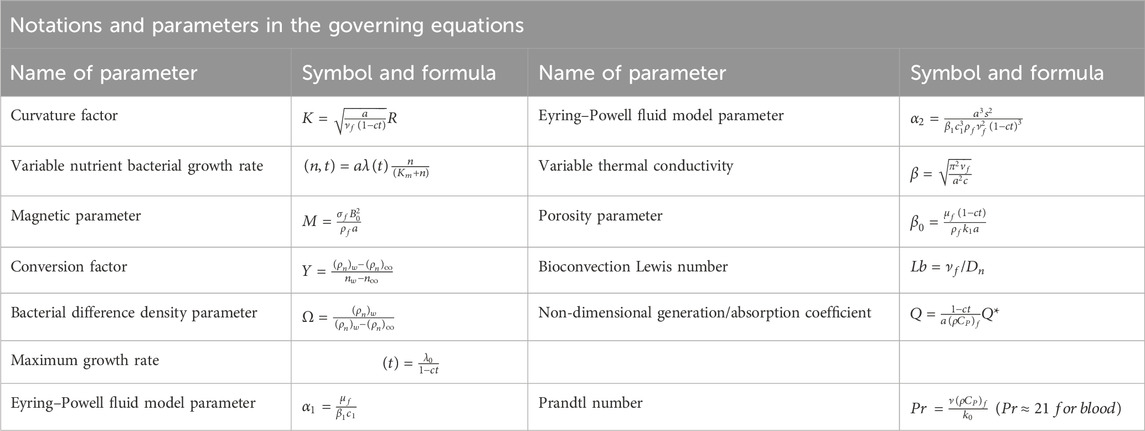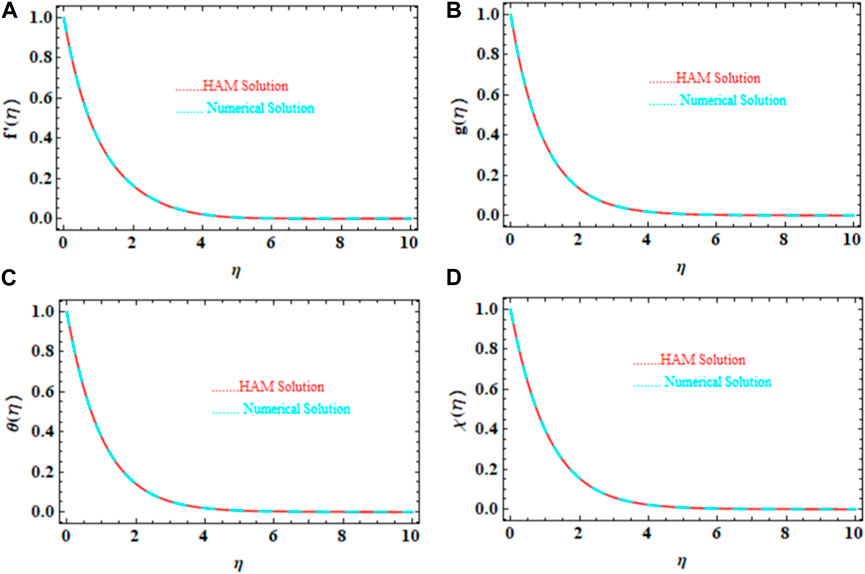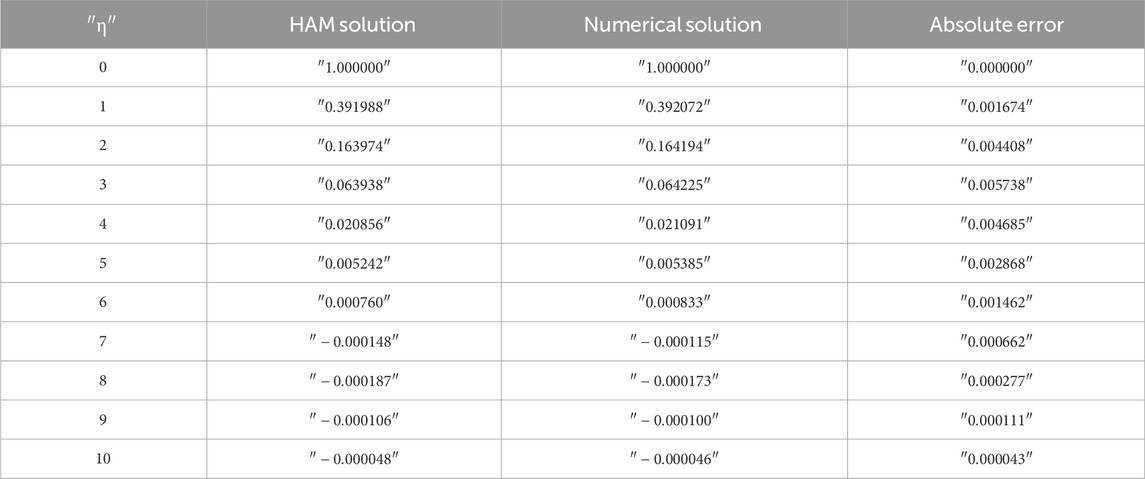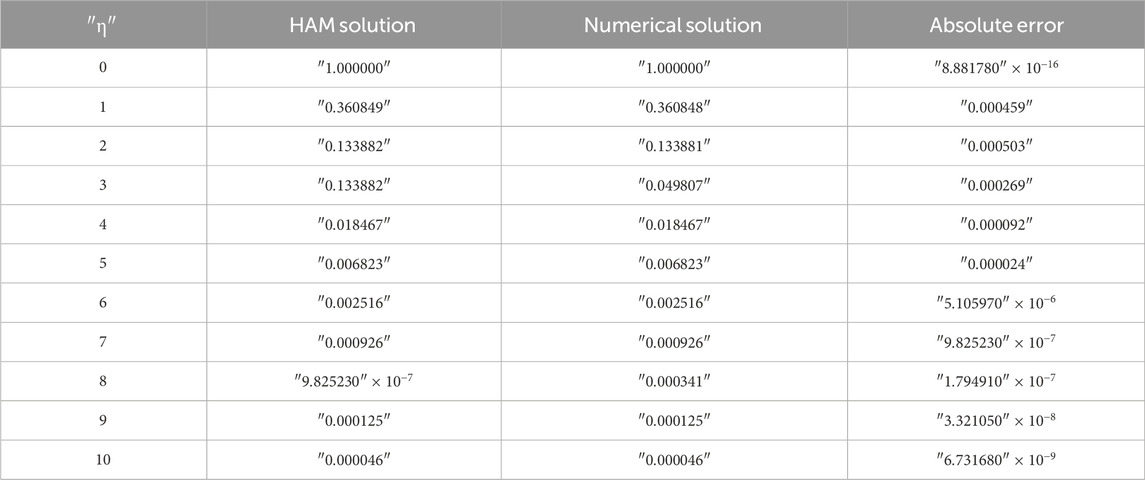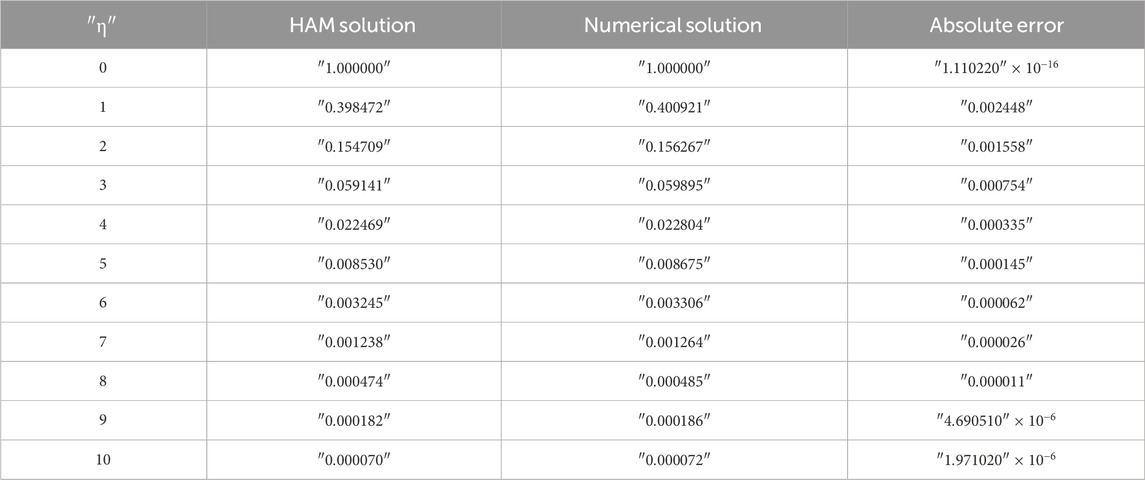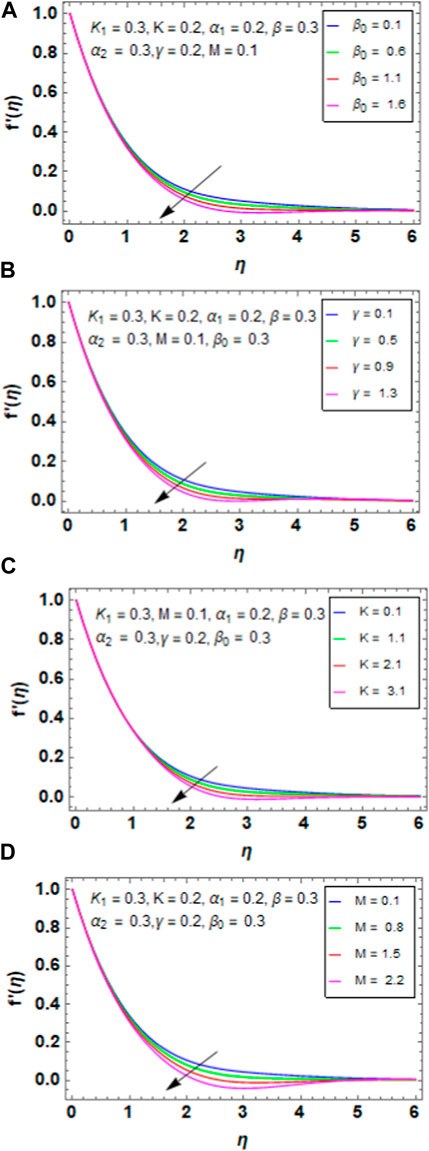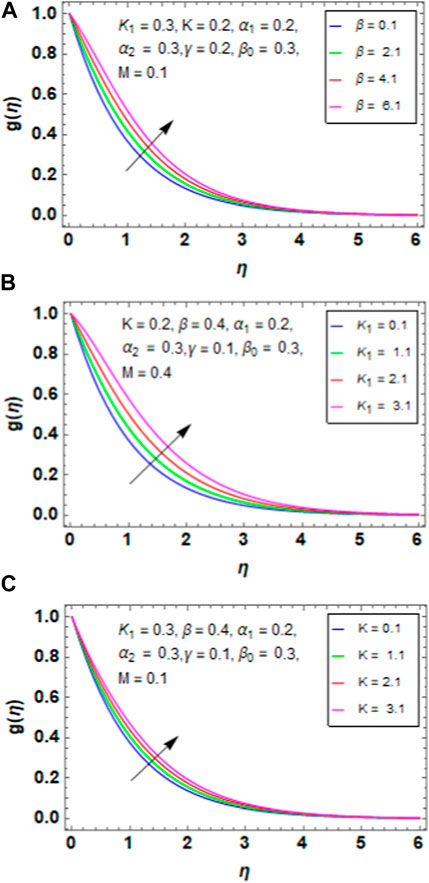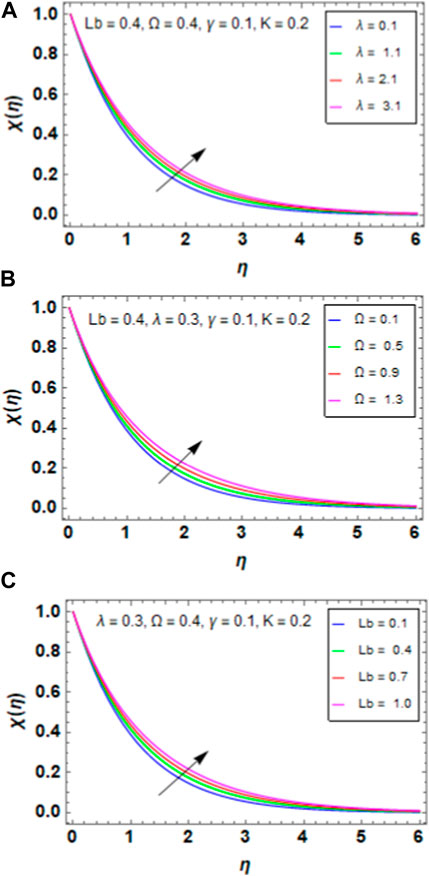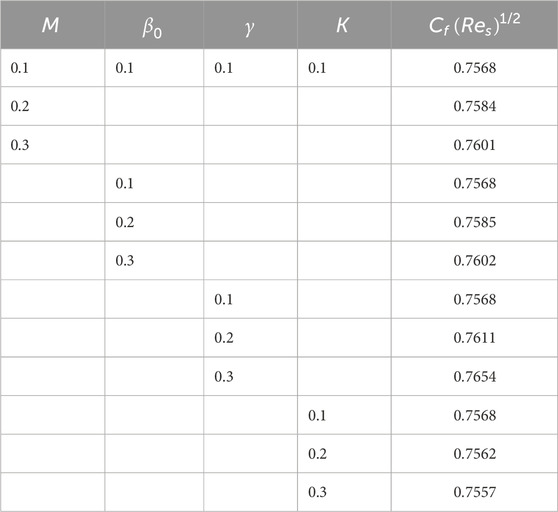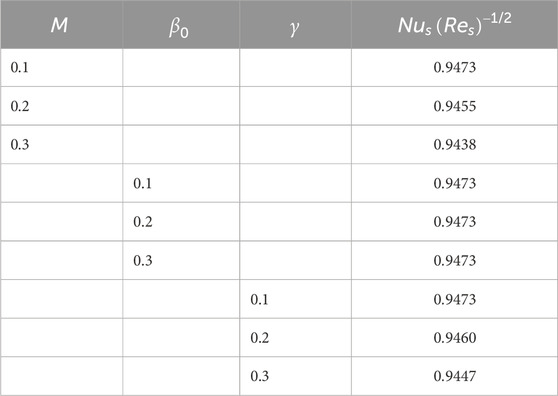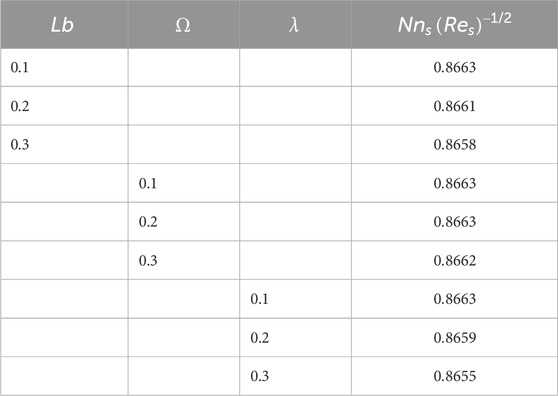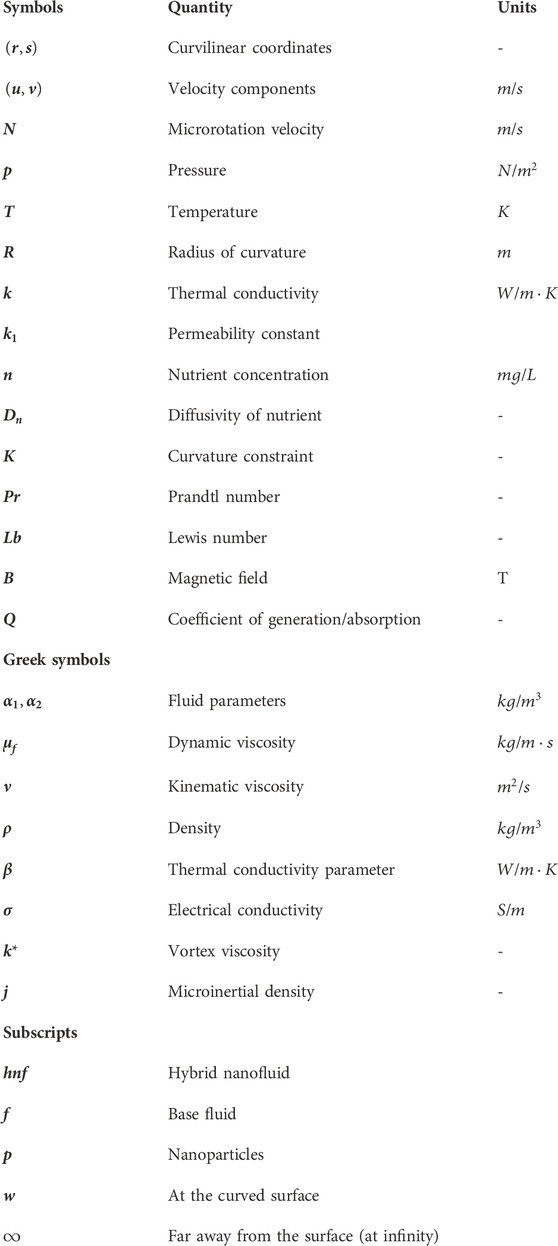- 1Department of Mathematics, College of Science and Arts, King Abdulaziz University, Rabigh, Saudi Arabia
- 2Department of Mathematical Sciences, University of Lakki Marwat, Lakki Marwat, Pakistan
- 3Faculty of Engineering, Department of Industrial Machines and Equipment, “Lucian Blaga” University of Sibiu, Sibiu, Romania
This work provides a brief comparative analysis of the influence of heat creation on micropolar blood-based unsteady magnetised hybrid nanofluid flow over a curved surface. The Powell–Eyring fluid model was applied for modelling purposes, and this work accounted for the impacts of both viscous dissipation and Joule heating. By investigating the behaviours of Ag and TiO2 nanoparticles dispersed in blood, we aimed to understand the intricate phenomenon of hybridisation. A mathematical framework was created in accordance with the fundamental flow assumptions to build the model. Then, the model was made dimensionless using similarity transformations. The problem of a dimensionless system was then effectively addressed using the homotopy analysis technique. A cylindrical surface was used to calculate the flow quantities, and the outcomes were visualised using graphs and tables. Additionally, a study was conducted to evaluate skin friction and heat transfer in relation to blood flow dynamics; heat transmission was enhanced to raise the Biot number values. According to the findings of this study, increasing the values of the unstable parameters results in increase of the blood velocity profile.
1 Introduction
Micropolar fluids are a type of polar fluid that have microscopic features located in the non-symmetric stress tensor. The presence of inflexible, spherical, or randomly oriented particles is a characteristic of a micropolar fluid. These particles show distinct microrotations and spins when suspended in a viscous liquid. These fluids are capable of a wide variety of microscale actions. Micropolar flow can be observed in many physical phenomena, such as blood flow, bubbling liquids, and liquid crystals. The most recent work on micropolar fluids by Xu and Pop (2014) combines advancements in nanofluids (NFs) and bioconvection. Aziz et al. (2012) theorised the boundary layer flow of the NF, including bioconvection. Agarwal et al. (1989) examined micropolar fluid flow across a stretched sheet using finite-element method for flow and heat transport solutions. Studies were conducted on the steady boundary layer flow across impermeable and permeable sheets in the presence of micropolar flow by Hassanien and Gorla (1990). Eringen (1966a) originally proposed the notion of micropolar fluids, and Abd El-Aziz (2013) studied the manner in which rotational dynamics behaved in micropolar fluids through individual particle motions. Spin inertia plays a role in maintaining the rotational momentum and stress in a body. The stagnant axisymmetric flow of a micropolar NF inside a rotating cylinder was studied by Nadeem et al. (2012). Balaram and Sastri (1973 explored free convection flow in a vertical parallel plate using a micropolar fluid. The two-dimensional flow at the asymmetric stagnation point was studied by Lok et al. (2003).
The goal of producing NF composites is to enhance the characteristics that distinguish nanoparticles, such as thermal conductivity. Framing can be used to produce NFs that are useful for increasing the volume of fluids so as to absorb thermal energy and enhance the rheological aspects. Accordingly, the enhanced thermal energy and rheological characteristic transfer in liquids render NF composites indispensable. Two nanoparticles can be combined to form a hybrid nanofluid (HNF); these nanoparticles, which are made of metals, oxides, or carbides, normally have sizes in the range of 1–100 nm. HNFs are significant in medicine, solar energy, and nuclear applications because they improve heat conductivity. Waini et al. (2019) investigated a HNF with variable volume fraction for copper nanoparticles and a fixed volume fraction of 0.1 for alumina nanoparticles flowing over a moving permeable surface. Sulochana et al. (2020) studied HNFs beyond the wedge and cone and found evidence of nonlinear radiation. Ashwinkumar et al. (2021) employed nonlinear thermal radiation to explore the flow of a
The term “fluid” under the influence of magnetic and electromagnetic forces is referred to as “magnetohydrodynamic” (MHD). Solar panels, polymer manufacturing, and highly conductive boilers are a few examples of applications that utilise MHD behaviours. Various studies have been conducted in this field because scientists aim to maintain the NFs under the influence of electromagnetic forces. The micro liquid squeezing flow in a medium under the effect of a magnetic field was investigated by Ghadikolaei et al. (2017). Ullah et al. (2017) examined the non-Newtonian fluid flow numerically over an enlarging sheet in the presence of a magnetic field using the Keller box method. Gul et al. (2015) studied the heat transport of a ferrofluid using a vertical tube in a magnetic field. Saqib et al. (2018) examined the flow of carbon-nanotube-based NFs in a channel under natural convection constraints; their results indicate that greater heat transfer improvement is attained when using lower volume fractions in comparison with the base fluid. Ma et al. (2019) conducted a numerical investigation on the MHD natural convection of NFs in a U-shaped baffled enclosure; they noted that the length of the baffle considerably impacts the flow and temperature patterns. It was also shown that heat transmission increases as the Hartman number increases at low Rayleigh numbers but decreases at large Rayleigh numbers. Khan et al. (2020) examined how the shapes of nanoparticles affect the features of peristaltic flow in MHD NFs within an asymmetric channel; their findings reveal that platelet-shaped particles exhibit higher heat transmission rates than brick or cylinder forms. Ghalambaz et al. (2019) studied the phenomenon of spontaneous convection in a confined space filled with a mixture of copper and aluminium oxide nanoparticles, which are known as Cu–Al2O3 HNFs, where enclosure was separated by a flexible membrane; they discovered that increasing the quantity of solid particles in the fluid improved heat transfer. On the other hand, the flexibility of the membrane caused a delay in the circulation of the NF. Equations were also derived to calculate the Nusselt number. Aman et al. (2018) provided precise solutions for the flow of a hybrid Casson NF in a porous medium by taking into account the MHD effects; this study demonstrated that the Casson and magnetic factors had substantial impacts on the velocity, nanoparticle concentration, and temperature. Das et al. (2017) studied the entropy produced for the flow of Cu–Al2O3 HNFs in an absorbent channel under MHD stimulus; their results indicate that there is a decrease in entropy production with increase in the volume fraction; the entropy generation number exhibited a positive correlation with the Hartman and Brinkman numbers. Anantha Kumar et al. (2020a) explored micropolar fluid flow with viscous dissipation effects over a thin stretching surface using a modified Fourier heat flux model for the analysis; they discovered that the temperature profiles decreased as the levels of viscous dissipation and micropolar parameters increased. Ramadevi et al. (2020) inspected the mixed convection flows of micropolar fluids by employing a modified Fourier heat flux model; their findings indicate that the velocity profiles decrease and the temperature and concentration profiles increase when considering the magnetic and viscous dissipation factors. Dawar et al. (2020) examined the chemically reactive MHD flows of micropolar NFs by considering the impacts of velocity slips and changing heat generation/absorption; they noted positive correlations between the temperature profiles and reaction rate parameters as well as negative correlations with heat absorption effects. Scientists and engineers are fascinated by the wide range of industrial applications of stretching sheets because of their heat transfer and boundary layer flow; these applications are often diverse and include hot rolling, gas blowing, metal spinning, wire drawing, polymer sheet extruding, and liquid composite moulding. Sakiadis (1961) described the results of constant speed over a solid boundary wall. Tsou et al. (1967) investigated the properties of heat transfer on a stretching sheet. Crane (1970) examined an analytical solution for the viscous fluid flow induced by a linearly stretched surface. To account for suction or blowing, Gupta and Gupta (1977) conducted an analysis of the effects of linear velocity across a stretchy sheet. Grubka and Bobba (1985) considered the linear velocity with changing temperature distribution while analysing the heat transfer characteristics. Magyari and Keller (1999) investigated exponential flow velocity and heat transmission with thermal dispersion effects over a stretching surface. Elbashbeshy (2001) extended the work by Keller and Magyari to determine how wind and suction affect a surface. Other relevant research works can be explored through references (Shah et al., 2024a; Grigore et al., 2017; Hasegan et al., 2019; Boicean et al., 2023; Shah et al., 2024b), from which readers may explore further into the subject matter to gain an inclusive understanding of the research landscape.
Scholars and mathematicians have been increasingly interested in studying fluid dynamics over curved surfaces because of their importance in technology and engineering. This phenomenon has significant consequences in several engineering disciplines, including fabrication of polymer sheets, rubbers, melt-spinning, paper making, and fibreglass. Micropolar fluid flow over a curved surface is a complex phenomenon that occurs in many scientific and practical applications. Scholars often explore complex flow patterns using mathematical models and numerical simulations to develop innovative methods for regulating and enhancing fluid flows in a range of settings. Alblawi et al. (2019) numerically investigated a curved surface that had been stretched exponentially. Ahmad and Khan (2019a) studied the effects of fluid flow using magneto-nanomaterials on a porous curved surface; the authors also conducted a computer study of the MHD movement of a Sisko nanomaterial fluid over a curved surface Ahmad and Khan, (2019b). Sheikholeslami et al. (2020) developed a mathematical model for MHD-based fluid flow of a nanomaterial over an inclined surface. Sajid et al. (2010) studied the flow of a micropolar fluid over a curved stretching surface. The continuous, incompressible flow of micropolar fluid across an exponentially curved surface was assessed by Shi et al. (2021) using a Keller box approach. Okechi et al. (2017) established the flow across a curved surface by accounting for the velocity and exponential similarity factors. Abbas et al. (2022) examined the time-dependent flow properties of a magnetised micropolar fluid adjacent to a curved surface. Anantha Kumar et al. (2020b) examined the Casson fluid issue in the context of heat radiation-influenced exponentially stretched curved surfaces. Other simulations and investigations of entropy analyses with applications may be seen in Ghachem et al. (2018), Elgazery et al. (2022), Rooman et al. (2022), and Maatki (2023).
1.1 Objective
The aim of this work was to computationally model and numerically analyse the behaviours of an unsteady magnetised micropolar blood-based HNF containing gold and copper nanoparticles as it flows over a curved surface. The Powell–Eyring fluid model was used in this study, and consideration was given to the viscous dissipation and Joule heating processes. The model objective was to contrast the performances of the HNF models. By investigating the behaviours of Ag and TiO2 nanoparticles dispersed in blood, our aim was to understand the intricate phenomenon of hybridisation. Artificial bacteria swim in an interstitial nanoliquid that is heated by Joule heating and variable thermal conductivity within a biotic cell. The effects of velocity slip and thermal jump were considered while analysing the curved surface. The basic flow assumptions were considered in the development of a mathematical framework. The numerical technique used to design the model verified previous analyses, demonstrating good agreement for a specific circumstance. The investigations delve into the impacts of various parameters, such as the Prandtl number, volume fraction of the nanoparticles, and blood flow parameters. The outcomes were meticulously elucidated through graphical representations and tabular summaries.
1.2 Novelty of the investigation
This study is unique and has a novel methodology because of the following:
• The integration of the different elements involved in the flow phenomenon has multiple implications for biomedical and technical applications.
• The use of a blood-based NF containing gold nanoparticles and blood-based HNF incorporation in combination with
• The curved surface consideration is useful for imitating medical devices with spinning components.
• The role of dissipative heat in conjunction with particle concentration is specifically attractive for the blood flow phenomenon, thereby improving the heat transmission qualities.
• We performed comparisons between the behaviours of an unsteady magnetised micropolar blood-based NF containing gold nanoparticles and a blood-based HNF incorporating both gold and copper nanoparticles.
• Gold nanoparticles (GNPs) are able to treat and kill cancerous tumours because of their large atomic numbers, which generate heat and aid in the treatment of the tumour. GNPs possess several other attributes that are critical for the treatment of cancer; even though they are small, they have the ability to penetrate deep within the body.
• Significantly, the findings of this research bear relevance to a broad spectrum of biomedical applications.
2 Model description
2.1 Formal model and geometry
We considered a two-dimensional unsteady boundary layer bioconvection flow of the Eyring–Powell micropolar blood-based magnetised HNF (containing Ag and TiO2 nanoparticles) over a porous curved stretching surface. The curvilinear coordinate system was chosen, where
• Unsteady, incompressible, and 2D boundary layer bioconvection flows of the Eyring–Powell micropolar blood-based magnetised hybrid NF (containing Ag and TiO2 nanoparticles) over a porous curved stretching surface are considered.
• The curvilinear coordinate system was chosen, where
• The velocity in the
• A varying magnetic field acts normal to the surface.
• A variable heat transfer is assumed.
• To describe the dynamics of bacterial density
Figure 1 illustrates the coordinate system, velocity field, and relevant elements of the flow problem geometry.
2.2 Mathematical formulation and basic equations
The constitutive equations characterising micropolar behaviour are constructed in vectorial form using new kinematic properties like the gyration tensor and micro-inertia moment tensor, in addition to the body moments, stress moments, and micro-stress. To take into consideration the magnetic effects, these equations are further enhanced, as follows (Ashraf and Wehgal, 2012; Eringen, 1966a):
Here, the velocity vector is represented by
The constitutive equations for the micropolar fluids are described in greater detail in Eringen (1966a). The equations for thermal energy and diffusion of nanoparticles, which are based on the Buongiorno model and obey the laws of Fourier and Fick, are described in Abbas et al. (2019).
where the temperature is represented by
Gyrotactic microorganisms are then taken into consideration according to Uddin et al. (2016).
where
The flow of microorganisms caused by fluid convection is represented by
Using cylindrical coordinates, the governing Eqs. (1–6) (Hashmi et al., 2012; Ashraf and Wehgal, 2012) are simplified by taking into account a magnetic field of the form
2.3 Eyring–Powell fluid model
The Eyring–Powell model was introduced in 1994 for defining shear in a non-Newtonian flow. Here, the stress–strain relationship is shown using the non-Newtonian Eyring–Powell model by the strain–stress tensor
where
2.4 Governing equations and boundary conditions after applying assumptions
The Navier–Stokes flow is a form of fluid motion in which the typical dimension and flow rotation speed,
where N represents the microrotation velocity. Here,
Subject to the boundary conditions as per Ma et al. (2019), we get
Here,
2.5 Similarity transformations and modelled ODEs
Consider the following dimensionless similarity transformation (Ma et al., 2019):
The continuity equation is met by the dimensionless quantity in Eq. (13), and upon pressure elimination, the governing Eqs. (7–12) can be represented as follows:
Similarly, pressure can be expressed as
Subject to boundary conditions
2.6 Thermophysical characteristics of the NF
2.6.1 Hybrid nanomaterial properties
The thermophysical characteristics and relations of the nano and hybrid nano materials are shown in Table 1 and Table 2, respectively. The properties and applications of the considered hybrid nanomaterials are shown in Figures 2A–C.

Table 1. Previous studies (Gul et al., 2015; Saqib et al., 2018; Ma et al., 2019) have analysed and reported the thermophysical characteristics of both the base fluid and HNF in great detail
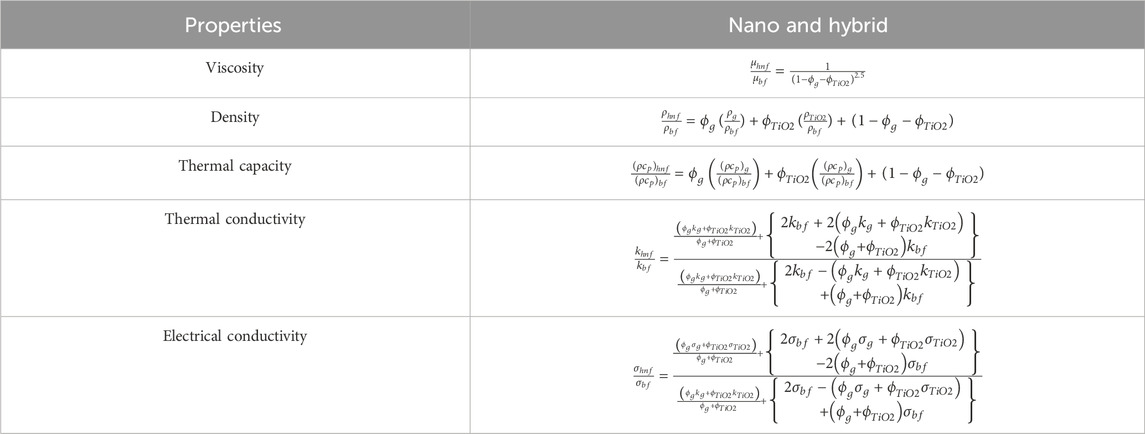
Table 2. Thermophysical interactions of nano and hybrid nano fluids (Takabi and Salehi, 2014).
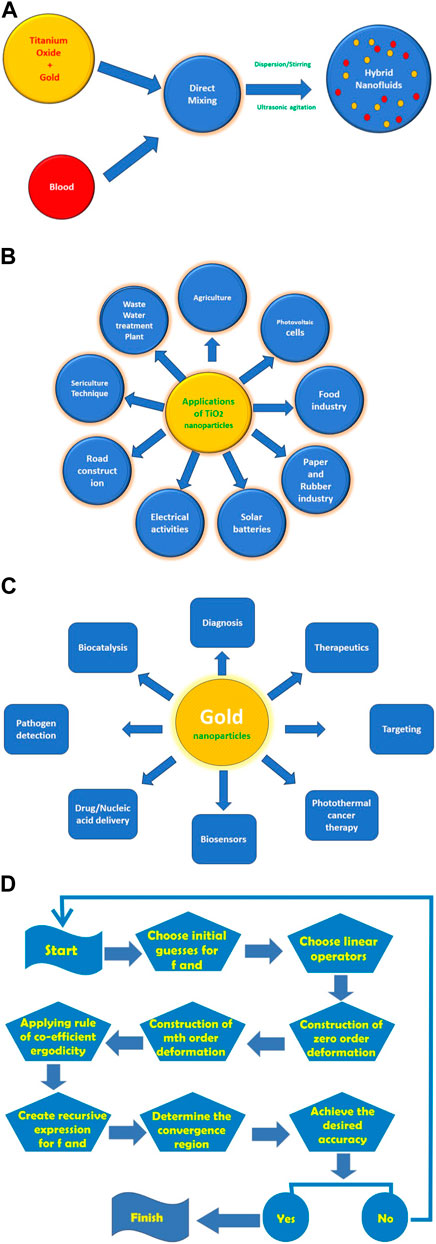
Figure 2. (A) Schematic for preparation of a hybrid nanofluid. (B) Schematic for applications of titanium dioxide (
2.6.2 Physical quantities of relevance
Examining the behaviour of the local skin-friction coefficient (
where
These values can be expressed in nondimensional forms as. From Eq. (13), the non-dimensional equation related to skin friction as well as the heat transfer and nutrient concentration are finally determined as follows:
where
3 Solution methodology
To solve Eqs. (14–18) under the boundary constraints of Eq. (19), we employ the homotopy analysis method (HAM) with the following steps. Figure 2D shows the flow chart for this method.
The solutions having the auxiliary parameters
The initial guesses are selected as follows:
The linear operators are taken as
with the following properties:
where
4 Validation of the results
The outcomes of the validations are presented both numerically and graphically in this work. The numerical (ND-Solved) approaches are juxtaposed with the semi-analytical HAM results for the velocity distributions
Figures 3A–D display the comparisons of the HAM and numerical solutions for
5 Results and discussion
In this investigation, the HAM is used to evaluate the efficacy of several regulating elements, such as the volume fraction
5.1 Velocity profile
Figure 4A shows the variations between the porosity parameter
5.2 Temperature profile
Figure 5A presents the variation between the porosity parameter

Figure 5. (A) Impact of
5.3 Microrotation profile
Figure 6A presents the variation between the variable thermal conductivity
5.4 Bacterial density field
Figure 7A presents the variation between the maximum growth rate of the bacteria
5.5 Graphical and numerical results of the skin-friction coefficient, Nusselt number, and nutrient concentration number
Figure 8A shows how the skin-friction coefficient is affected by

Figure 8. (A) Variations in skin friction
The changes in the Nusselt number
The fluctuations of the nutrient concentration number for various values of
Table 7 illustrates the impacts of varying values of the magnetic parameter
Table 8 illustrates the trend of the Nusselt number for incremental values of the magnetic parameter
6 Conclusion
A mathematical analysis of the impact of heat generation on an unsteady magnetised Powell–Eyring micropolar blood-based hybrid nanofluid over a curved surface is reported in this work. This model’s objective is to contrast the performances of the HNF models. The effects of thermal jump and velocity slip are considered when analysing the curved surface. The mathematical model was formulated based on the underlying flow assumptions. The cylindrical surface is utilised to calculate the flow quantities, and the outcomes are visually presented using graphs and tables. The following conclusions may be drawn from the results of this work:
• This study significantly contributes to literature by uncovering novel flow features that were previously unexplored.
• The utilisation of gold nanoparticles shows potential for enhancing blood circulation and presents a promising therapeutic strategy for combating arterial diseases, in contrast to copper and aluminium oxide nanoparticles.
• The proposed strategy has advantages for effective delivery of medication through blood, as seen from the graphical findings and numerical solutions.
• The ratio of fluid to surface increases and rate of heat transfer decreases when the magnetic field is increased.
• Heat transmission enhancement increases the Biot number value. It was found that the blood velocity profile could be improved by increasing the values of the unstable parameters.
• As the porosity parameter, magnetic parameter, and magnetite volume percentage increase, the velocity distribution decreases.
• The distribution of blood temperature increases with the concentration of the magnetite nanoparticles. It is therefore possible to enhance the physical properties of the blood by submerging the magnetite nanoparticles.
• The current findings show that boosting the heat transfer rate is dependent on the magnetic parameter and Eckert number.
• The increasing behaviour of skin friction (Cf) with increasing values of the magnetic parameter (M) for the HNF is observed.
• The increase in the total bacterial density field inside the HNF is a result of the increased availability of nutrition, which encourages bacterial growth and replication.
• As the cooling over the curved surface improves, the temperature of the HNF drops.
Data availability statement
The data that support the findings of the study are available from the corresponding author upon reasonable request.
Author contributions
WD: formal analysis, investigation, methodology, software, visualization, and writing–original draft. ZS: conceptualization, investigation, methodology, supervision, validation, and writing–original draft. MR: conceptualization, data curation, formal analysis, investigation, methodology, software, and writing–review and editing. NK: data curation, formal analysis, investigation, methodology, and writing–original draft. NV: funding acquisition, project administration, resources, validation, visualization, and writing–original draft. MS: data curation, formal analysis, investigation, methodology, validation, and writing–review and editing.
Funding
The author(s) declare financial support was received for the research, authorship, and/or publication of this article.
Acknowledgments
Project financed by the Lucian Blaga University of Sibiu through a research grant (no. LBUS-IRG-2023).
Conflict of interest
The authors declare that the research was conducted in the absence of any commercial or financial relationships that could be construed as a potential conflict of interest.
Publisher’s note
All claims expressed in this article are solely those of the authors and do not necessarily represent those of their affiliated organizations or those of the publisher, editors, and reviewers. Any product that may be evaluated in this article or claim that may be made by its manufacturer is not guaranteed or endorsed by the publisher.
References
Abbas, N., Nadeem, S., and Khan, M. N. (2022). Numerical analysis of unsteady magnetized micropolar fluid flow over a curved surface. J. Therm. Anal. Calorim. 147 (11), 6449–6459. doi:10.1007/s10973-021-10913-0
Abbas, Z., Mushtaq, T., Shehzad, S. A., Rauf, A., and Kumar, R. (2019). Slip flow of hydromagnetic micropolar nanofluid between two disks with characterization of porous medium. J. Braz. Soc. Mech. Sci. Eng. 41 (10), 465. doi:10.1007/s40430-019-1974-6
Abd El-Aziz, M. (2013). Mixed convection flow of a micropolar fluid from an unsteady stretching surface with viscous dissipation. J. Egypt. Math. Soc. 21 (3), 385–394. doi:10.1016/j.joems.2013.02.010
Acharya, N. (2021). Spectral quasi linearization simulation on the hydrothermal behavior of hybrid nanofluid spraying on an inclined spinning disk. Partial Differ. Equ. Appl. Math. 4, 100094. doi:10.1016/j.padiff.2021.100094
Agarwal, R. S., Bhargava, R., and Balaji, A. V. S. (1989). Finite element solution of flow and heat transfer of a micropolar fluid over a stretching sheet. Int. J. Eng. Sci. 27 (11), 1421–1428. doi:10.1016/0020-7225(89)90065-7
Ahmad, L., and Khan, M. (2019a). Importance of activation energy in development of chemical covalent bonding in flow of Sisko magneto-nanofluids over a porous moving curved surface. Int. J. Hydrog. Energy 44 (21), 10197–10206. doi:10.1016/j.ijhydene.2019.02.162
Ahmad, L., and Khan, M. (2019b). Numerical simulation for MHD flow of Sisko nanofluid over a moving curved surface: a revised model. Microsyst. Technol. 25 (6), 2411–2428. doi:10.1007/s00542-018-4128-3
Alblawi, A., Malik, M. Y., Nadeem, S., and Abbas, N. (2019). Buongiorno’s nanofluid model over a curved exponentially stretching surface. Processes 7 (10), 665. Art. no. 10. doi:10.3390/pr7100665
Aman, S., Zokri, S. M., Ismail, Z., Salleh, M. Z., and Khan, I., “Effect of MHD and porosity on exact solutions and flow of a hybrid casson-nanofluid,” J. Adv. Res. Fluid Mech. Therm. Sci., vol. 44, 2018.
Anantha Kumar, K., Sugunamma, V., and Sandeep, N. (2020a). Influence of viscous dissipation on MHD flow of micropolar fluid over a slendering stretching surface with modified heat flux model. J. Therm. Anal. Calorim. 139 (6), 3661–3674. doi:10.1007/s10973-019-08694-8
Anantha Kumar, K., Sugunamma, V., and Sandeep, N. (2020b). Effect of thermal radiation on MHD Casson fluid flow over an exponentially stretching curved sheet. J. Therm. Anal. Calorim. 140 (5), 2377–2385. doi:10.1007/s10973-019-08977-0
Ashraf, M., and Wehgal, A. R. (2012). MHD flow and heat transfer of micropolar fluid between two porous disks. Appl. Math. Mech. 33 (1), 51–64. doi:10.1007/s10483-012-1533-6
Ashwinkumar, G. P., Samrat, S. P., and Sandeep, N. (2021). Convective heat transfer in MHD hybrid nanofluid flow over two different geometries. Int. Commun. Heat. Mass Transf. 127, 105563. doi:10.1016/j.icheatmasstransfer.2021.105563
Aziz, A., Khan, W. A., and Pop, I. (2012). Free convection boundary layer flow past a horizontal flat plate embedded in porous medium filled by nanofluid containing gyrotactic microorganisms. Int. J. Therm. Sci. 56, 48–57. doi:10.1016/j.ijthermalsci.2012.01.011
Balaram, M., and Sastri, V. U. K. (1973). Micropolar free convection flow. Int. J. Heat. Mass Transf. 16 (2), 437–441. doi:10.1016/0017-9310(73)90070-7
Boicean, A., Bratu, D., Bacila, C., Tanasescu, C., Fleaca, R. S., Mohor, C. I., et al. (2023). Therapeutic perspectives for microbiota transplantation in digestive diseases and neoplasia—a literature review. Pathogens 12 (6), 766. doi:10.3390/pathogens12060766
Crane, L. J. (1970). Flow past a stretching plate. Z. Für Angew. Math. Phys. ZAMP 21 (4), 645–647. doi:10.1007/BF01587695
Das, S., Jana, R. N., and Makinde, O. D. (2017). MHD flow of Cu-Al2O3/water hybrid nanofluid in porous channel: analysis of entropy generation. Defect Diffus. Forum 377, 42–61.
Dawar, A., Shah, Z., Kumam, P., Alrabaiah, H., Khan, W., Islam, S., et al. (2020). Chemically reactive MHD micropolar nanofluid flow with velocity slips and variable heat source/sink. Sci. Rep. 10 (1), 20926. doi:10.1038/s41598-020-77615-9
Elbashbeshy, E. M. A., “Heat transfer over an exponentially stretching continuous surface with suction,” Arch. Mech., vol. 53, 2001. doi:10.24423/aom.80
Elgazery, N. S., Elelamy, A. F., Bobescu, E., and Ellahi, R. (2022). How do artificial bacteria behave in magnetized nanofluid with variable thermal conductivity: application of tumor reduction and cancer cells destruction. Int. J. Numer. Methods Heat. Fluid Flow. 32 (9), 2982–3006. doi:10.1108/hff-11-2021-0722
Eringen, A. C. (1966a). Theory of micropolar fluids. J. Math. Mech. 16 (1), 1–18. doi:10.1512/iumj.1967.16.16001
Garia, R., Rawat, S. K., Kumar, M., and Yaseen, M. (2021). Hybrid nanofluid flow over two different geometries with Cattaneo–Christov heat flux model and heat generation: a model with correlation coefficient and probable error. Chin. J. Phys. 74, 421–439. doi:10.1016/j.cjph.2021.10.030
Ghachem, K., Hassen, W., Maatki, C., Kolsi, L., Al-Rashed, A. A. A. A., and Borjini, M. N. (2018). Numerical simulation of 3D natural convection and entropy generation in a cubic cavity equipped with an adiabatic baffle. Int. J. Heat. Technol. 36 (3), 1047–1054. doi:10.18280/IJHT.360335
Ghadikolaei, S. S., Yassari, M., Sadeghi, H., Hosseinzadeh, Kh., and Ganji, D. D. (2017). Investigation on thermophysical properties of Tio2–Cu/H2O hybrid nanofluid transport dependent on shape factor in MHD stagnation point flow. Powder Technol. 322, 428–438. doi:10.1016/j.powtec.2017.09.006
Ghalambaz, M., Mehryan, S. A. M., Izadpanahi, E., Chamkha, A. J., and Wen, D. (2019). MHD natural convection of Cu–Al2O3 water hybrid nanofluids in a cavity equally divided into two parts by a vertical flexible partition membrane. J. Therm. Anal. Calorim. 138 (2), 1723–1743. doi:10.1007/s10973-019-08258-w
Grigore, N., Pirvut, V., Totan, M., Bratu, D., I Cernușcă Mitariu, S., Cernusca Mitariu, M., et al. (2017). The evaluation of biochemical and microbiological parameters in the diagnosis of emphysematous pyelonephritis. Rev. Chim. 68, 1285–1288. doi:10.37358/RC.17.6.5658
Grubka, L. J., and Bobba, K. M. (1985). Heat transfer characteristics of a continuous, stretching surface with variable temperature. J. Heat. Transf. 107 (1), 248–250. doi:10.1115/1.3247387
Gul, A., Khan, I., Shafie, S., Khalid, A., and Khan, A. (2015). Heat transfer in MHD mixed convection flow of a ferrofluid along a vertical channel. PLOS ONE 10 (11), e0141213. doi:10.1371/journal.pone.0141213
Gupta, P. S., and Gupta, A. S. (1977). Heat and mass transfer on a stretching sheet with suction or blowing. Can. J. Chem. Eng. 55 (6), 744–746. doi:10.1002/cjce.5450550619
Hasegan, T. M., Antonescu, E., Bumbu, A. G., Pantis, C., Furau, C., Urducea, C. B., et al. (2019). Prevalence of urinary tract infections in children and changes in sensitivity to antibiotics of E. coli Strains, A. J. Rev. Chim. 70, 3788–3792. doi:10.37358/RC.70.19.11.7648
Hashmi, M. M. M., Hayat, T., and Alsaedi, A. (2012). On the analytic solutions for squeezing flow of nanofluid between parallel disks. Nonlinear Anal. Model. Control 17, 418–430. doi:10.15388/NA.17.4.14048
Hassanien, I. A., and Gorla, R. S. R. (1990). Heat transfer to a micropolar fluid from a non-isothermal stretching sheet with suction and blowing. Acta Mech. 84 (1–4), 191–199. doi:10.1007/BF01176097
Khan, L. A., Raza, M., Mir, N. A., and Ellahi, R. (2020). Effects of different shapes of nanoparticles on peristaltic flow of MHD nanofluids filled in an asymmetric channel: a novel mode for heat transfer enhancement. J. Therm. Anal. Calorim. 140 (3), 879–890. doi:10.1007/s10973-019-08348-9
Lok, Y. Y., Amin, N., and Pop, I. (2003). Steady two-dimensional asymmetric stagnation point flow of a micropolar fluid. ZAMM - J. Appl. Math. Mech. Z. Für Angew. Math. Mech. 83 (9), 594–602. doi:10.1002/zamm.200310050
Ma, Y., Mohebbi, R., Rashidi, M. M., Yang, Z., and Sheremet, M. A. (2019). Numerical study of MHD nanofluid natural convection in a baffled U-shaped enclosure. Int. J. Heat. Mass Transf. 130, 123–134. doi:10.1016/j.ijheatmasstransfer.2018.10.072
Maatki, C., “Numerical analysis of entropy generation in a double stage triangular solar still using CNT-nanofluid under double-diffusive natural convection,” Math. 2023, Vol. 11, Page 2818. doi:10.3390/MATH11132818
Magyari, E., and Keller, B. (1999). Heat and mass transfer in the boundary layers on an exponentially stretching continuous surface. J. Phys. Appl. Phys. 32 (5), 577–585. doi:10.1088/0022-3727/32/5/012
Nadeem, S., Rehman, A., Vajravelu, K., Lee, J., and Lee, C. (2012). Axisymmetric stagnation flow of a micropolar nanofluid in a moving cylinder. Math. Probl. Eng. 2012, 1–18. doi:10.1155/2012/378259
Okechi, N. F., Jalil, M., and Asghar, S. (2017). Flow of viscous fluid along an exponentially stretching curved surface. Results Phys. 7, 2851–2854. doi:10.1016/j.rinp.2017.07.059
Ramadevi, B., Anantha Kumar, K., Sugunamma, V., Ramana Reddy, J. V., and Sandeep, N. (2020). Magnetohydrodynamic mixed convective flow of micropolar fluid past a stretching surface using modified Fourier’s heat flux model. J. Therm. Anal. Calorim. 139 (2), 1379–1393. doi:10.1007/s10973-019-08477-1
Rooman, M., Jan, M. A., hah, Z., Vrinceanu, N., Ferrándiz Bou, S., Iqbal, S., et al. (2022). Entropy optimization on axisymmetric Darcy–forchheimer powell–eyring nanofluid over a horizontally stretching cylinder with viscous dissipation effect. Coatings 12, 749. doi:10.3390/coatings12060749
Sajid, M., Ali, N., Javed, T., and Abbas, Z. (2010). Stretching a curved surface in a viscous fluid. Chin. Phys. Lett. 27 (2), 024703. doi:10.1088/0256-307X/27/2/024703
Sakiadis, B. C. (1961). Boundary-layer behavior on continuous solid surfaces: I. Boundary-layer equations for two-dimensional and axisymmetric flow. AIChE J. 7 (1), 26–28. doi:10.1002/aic.690070108
Samrat, S., Ashwinkumar, G., and Sandeep, N. (2021). Simultaneous solutions for convective heat transfer in dusty-nano- and dusty-hybrid nanoliquids. Proc. Inst. Mech. Eng. Part E J. Process Mech. Eng., 095440892110436. doi:10.1177/09544089211043605
Saqib, M., Khan, I., and Shafie, S. (2018). Natural convection channel flow of CMC-based CNTs nanofluid. Eur. Phys. J. Plus 133 (12), 549. doi:10.1140/epjp/i2018-12340-3
Sarwar, L., and Hussain, A. (2021). Flow characteristics of Au-blood nanofluid in stenotic artery. Int. Commun. Heat. Mass Transf. 127, 105486. doi:10.1016/j.icheatmasstransfer.2021.105486
Shah, Z., Sulaiman, M., Dawar, A., Alshehri, M. H., and Vrinceanu, N. (2024b). Darcy–Forchheimer MHD rotationally symmetric micropolar hybrid-nanofluid flow with melting heat transfer over a radially stretchable porous rotating disk. J. Therm. Anal. Calorim. doi:10.1007/s10973-024-12986-z
Shah, Z., Sulaiman, M., Khan, W., Vrinceanu, N., and Alshehri, M. H. (2024a). Gyrotactic microorganism's and heat transfer analysis of water conveying MHD SWCNT nanoparticles using fourth-grade fluid model over Riga plate. Case Stud. Therm. Eng. 55, 104119. doi:10.1016/j.csite.2024.104119
Sheikholeslami, M., Arabkoohsar, A., and Babazadeh, H. (2020). Modeling of nanomaterial treatment through a porous space including magnetic forces. J. Therm. Anal. Calorim. 140 (2), 825–834. doi:10.1007/s10973-019-08878-2
Shi, Q.-H., Shabbir, T., Mushtaq, M., Khan, M. I., Shah, Z., and Kumam, P. (2021). Modelling and numerical computation for flow of micropolar fluid towards an exponential curved surface: a Keller box method. Sci. Rep. 11 (1), 16351. doi:10.1038/s41598-021-95859-x
Subhani, M., and Nadeem, S. (2019). Numerical analysis of micropolar hybrid nanofluid. Appl. Nanosci. 9 (4), 447–459. doi:10.1007/s13204-018-0926-2
Sulochana, C., Aparna, S. R., and Sandeep, N. (2020). Magnetohydrodynamic MgO/CuO-water hybrid nanofluid flow driven by two distinct geometries. Heat. Transf. 49 (6), 3663–3682. doi:10.1002/htj.21794
Takabi, B., and Salehi, S., (2014), “Augmentation of the heat transfer performance of a sinusoidal corrugated enclosure by employing hybrid nanofluid,”2014, 147059. doi:10.1155/2014/147059
Tsou, F. K., Sparrow, E. M., and Goldstein, R. J. (1967). Flow and heat transfer in the boundary layer on a continuous moving surface. Int. J. Heat. Mass Transf. 10 (2), 219–235. doi:10.1016/0017-9310(67)90100-7
Uddin, M. J., Alginahi, Y., Bég, O. A., and Kabir, M. N. (2016). Numerical solutions for gyrotactic bioconvection in nanofluid-saturated porous media with Stefan blowing and multiple slip effects. Comput. Math. Appl. 72 (10), 2562–2581. doi:10.1016/j.camwa.2016.09.018
Ullah, I., Shafie, S., and Khan, I. (2017). Effects of slip condition and Newtonian heating on MHD flow of Casson fluid over a nonlinearly stretching sheet saturated in a porous medium. J. King Saud. Univ. - Sci. 29 (2), 250–259. doi:10.1016/j.jksus.2016.05.003
Waini, I., Ishak, A., and Pop, I. (2019). Hybrid nanofluid flow and heat transfer past a vertical thin needle with prescribed surface heat flux. Int. J. Numer. Methods Heat. Fluid Flow. 29 (12), 4875–4894. doi:10.1108/HFF-04-2019-0277
Xu, H., and Pop, I. (2014). Mixed convection flow of a nanofluid over a stretching surface with uniform free stream in the presence of both nanoparticles and gyrotactic microorganisms. Int. J. Heat. Mass Transf. 75, 610–623. doi:10.1016/j.ijheatmasstransfer.2014.03.086
Nomenclature
Keywords: hybrid nanofluid, Eyring–Powell fluid model, micropolar blood-based flow, porous medium, Joule heating, curved boundary
Citation: Deebani W, Shah Z, Rooman M, Khan NU, Vrinceanu N and Shutaywi M (2024) Computational modelling of micropolar blood-based magnetised hybrid nanofluid flow over a porous curved surface in the presence of artificial bacteria. Front. Chem. 12:1397066. doi: 10.3389/fchem.2024.1397066
Received: 06 March 2024; Accepted: 15 April 2024;
Published: 05 June 2024.
Edited by:
Lioua Kolsi, University of Hail, Saudi ArabiaReviewed by:
Walid Aich, University of Hail, Saudi ArabiaChemseddine Maatki, Imam Muhammad ibn Saud Islamic University, Saudi Arabia
Copyright © 2024 Deebani, Shah, Rooman, Khan, Vrinceanu and Shutaywi. This is an open-access article distributed under the terms of the Creative Commons Attribution License (CC BY). The use, distribution or reproduction in other forums is permitted, provided the original author(s) and the copyright owner(s) are credited and that the original publication in this journal is cited, in accordance with accepted academic practice. No use, distribution or reproduction is permitted which does not comply with these terms.
*Correspondence: Zahir Shah, WmFoaXJAdWxtLmVkdS5waw==; Narcisa Vrinceanu, dnJpbmNlYW51Lm5hcmNpc2FpQHVsYnNpYml1LnJv
 Wejdan Deebani1
Wejdan Deebani1 Zahir Shah
Zahir Shah Muhammad Rooman
Muhammad Rooman Narcisa Vrinceanu
Narcisa Vrinceanu Meshal Shutaywi
Meshal Shutaywi